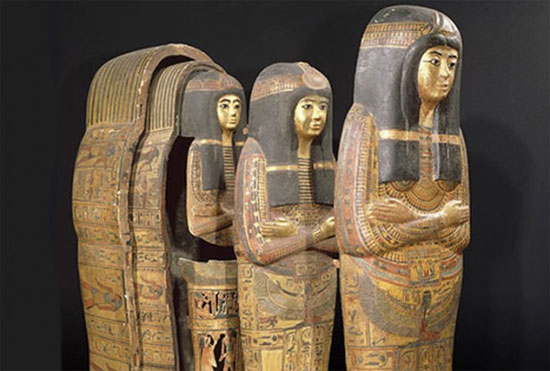The reason the Egyptians put mummies in many coffins
The inclusion of many coffins at burial shows not only the upper class, but the Egyptians believe that this will help the deceased to relate to their ancestors.
The upper classes of ancient Egypt often placed coffins in three or four classes, especially mummies of King Tutankhamun (1334-1324 BC) placed in eight coffins interlocking.
Dr. Anders Bettum from the University of Oslo, an Oriental language and cultural researcher, said that the inclusion of many burial coffins is not only a symbol for the Egyptian elite, but also by the Egyptians. It is believed that it helps the deceased to contact their ancestors.

A layered coffin of Tamutnofret temple, predicted from the time of Ramses II (ca. 1279-1213 BC) included an inner coffin, a 'mummy shell', a mask covering Mummies.(Photo: Réunion d es Musées Nationaux)
The funeral rituals that take place in 70 days are expressed in the details of the flower on the coffin."Decorations, symbols and materials represent the unity of the gods Osiris and Amun-Ra," Redorbit quoted Buttum as saying.
"Outside the coffin, the deceased is described as Osiris, with a mummy with a blue striped wig and a dignified face. The coffin is painted yellow varnish. The rich Egyptians often have gold in them. on their coffin , 'added Buttum.
The decorative pattern is the image of the gods Osiris and Amun-Ra. The god of the sun Osiris will arrive in the throne during the sixth hour of the night and the two gods will converge in the occult. The Egyptians believed that these two gods were the source of all rebirth in nature, and they came here, creating the origin of life.
The innermost layer of the coffin is decorated like the best costumes of the deceased while alive. This is the most important class because it represents the goal of moving to the afterlife.
'The remaining coffins are like repeated images of the deceased, and it is a protective layer, similar to larvae of larvae before transforming themselves into butterflies. This is also a famous topic in art, religion and literature , 'explained Bettum.
Buttum said that many coffins are now separated from classes and they are scattered throughout the world. He hoped international archaeologists would cooperate to reassemble in order to further study the ancient Egyptian culture. However, national legal and interest barriers hinder and make this difficult to come true.
- How does the Egyptian manipulate the mummy coffin?
- New news about 3 mummies in a black coffin 2,000 years in Egypt
- Detect the beautiful mummy casket cap
- The mystery of the 17 wooden caskets contains tiny mummies
- Egypt discovered an ancient graveyard of more than 2,000 years old
- The boy found 'mummy' in the attic
- Shivering 'beasts' eating mummies in ancient times
- The mysterious mummy survived for thousands of years, suddenly ... liquefied
- The mystery of the mummies
- Open the lid of 30 ancient coffins, shocked at what's inside
- 6 things we do not know about the people of ancient Egypt
- Video: Processing process to help the Egyptian school mummy survive for thousands of years
 'Fine laughs' - Scary and painful torture in ancient times
'Fine laughs' - Scary and painful torture in ancient times The sequence of numbers 142857 of the Egyptian pyramids is known as the strangest number in the world - Why?
The sequence of numbers 142857 of the Egyptian pyramids is known as the strangest number in the world - Why? History of the iron
History of the iron What is alum?
What is alum?